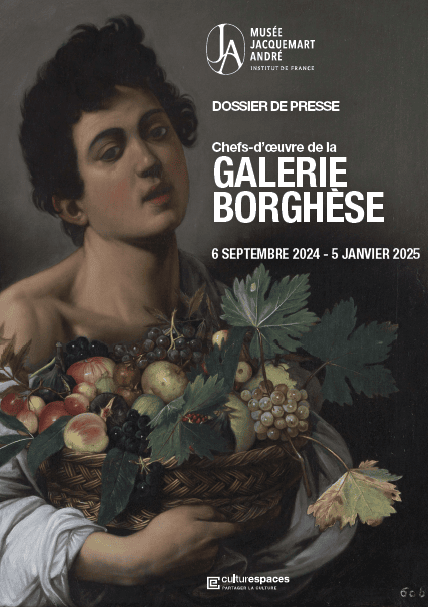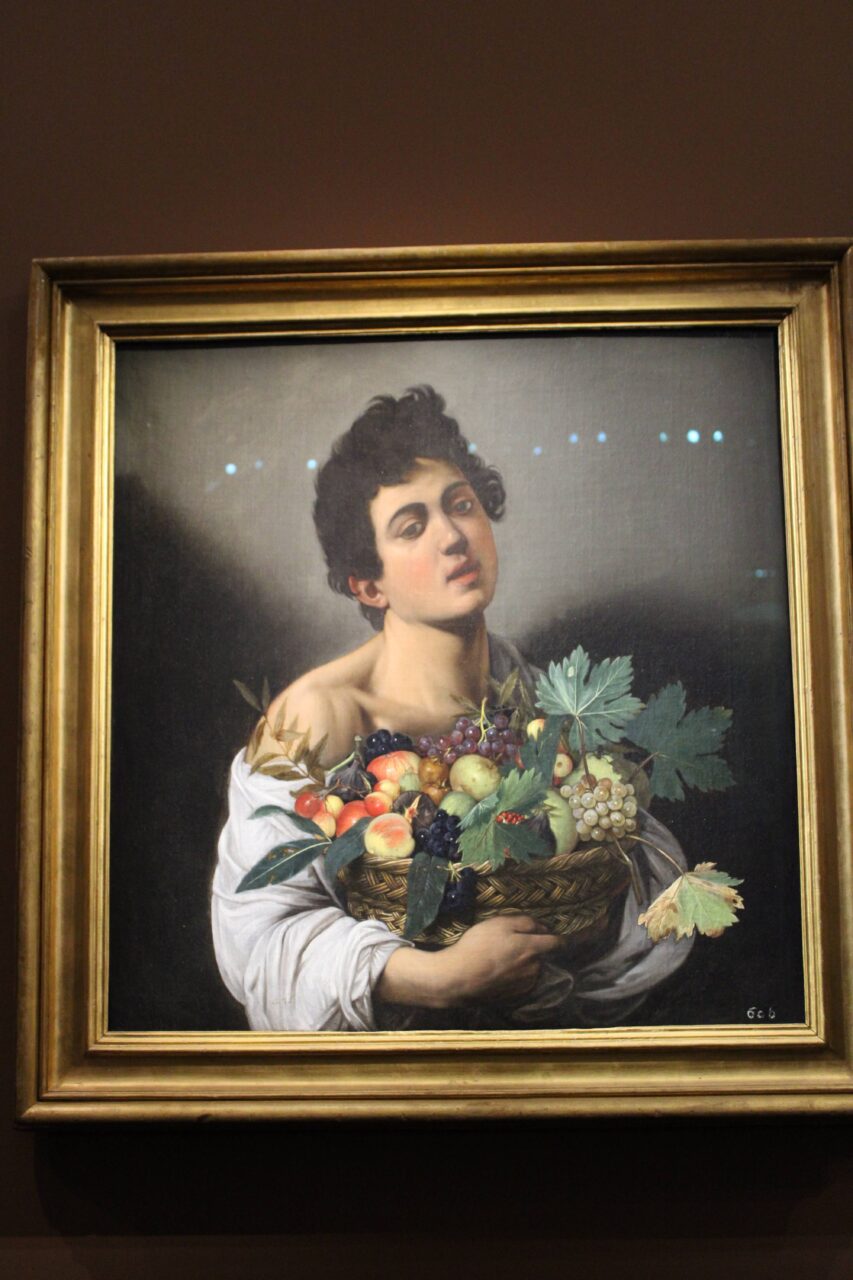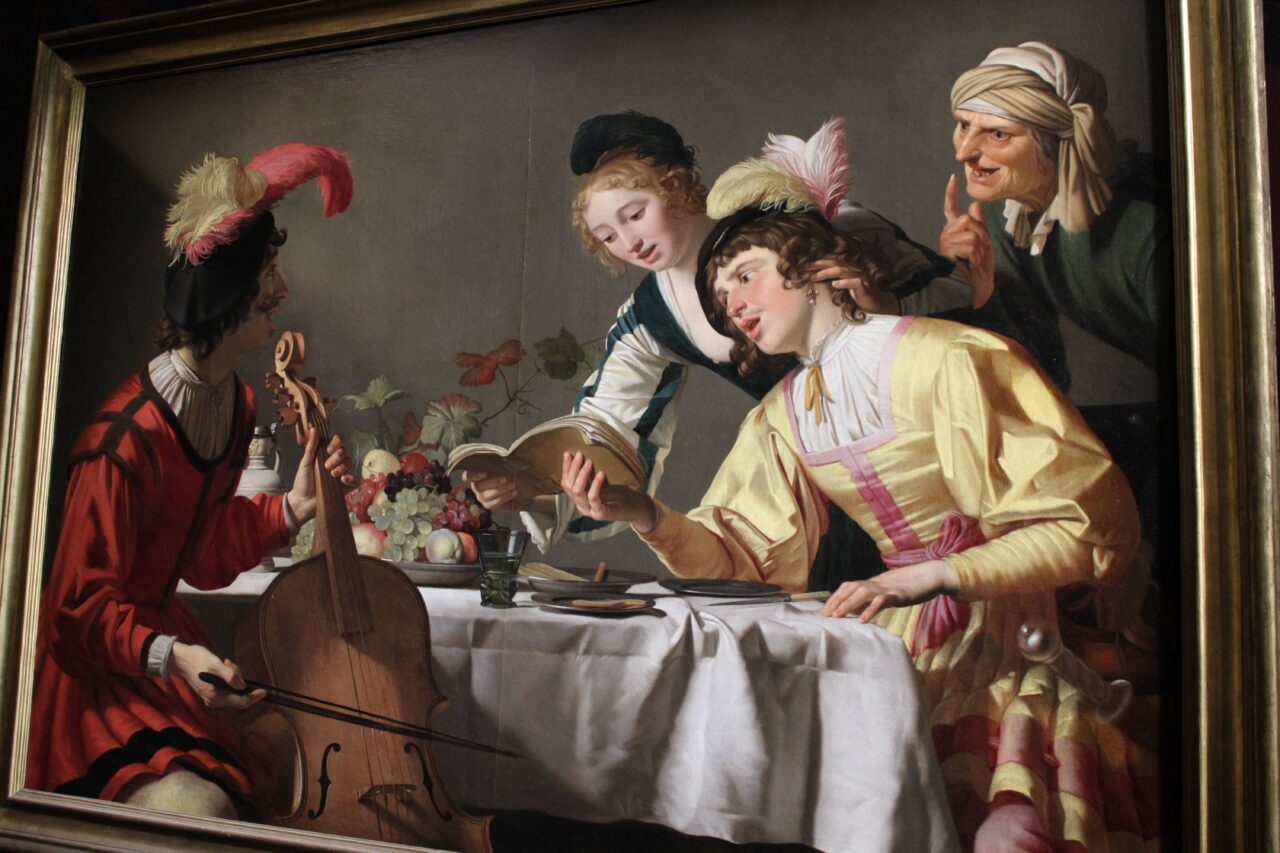Recently, Italian art collections have been in the spotlight in Parisian museums! After two remarkable exhibitions at the Louvre Museum, it is the turn of the Jacquemart-André Museum. For its first exhibition after a closure of more than a year due to renovation work, the museum situated in the 8th arrondissement of Paris, reopen with a collection that is rarely presented out of Italy. “Masterpieces from the Borghese Gallery” (06.09.2024 – 05.01.2025) reunites about forty well-known art pieces (paintings, sculptures…) from the Roman museum, realized by famous artists like Botticelli, Raphael, Titian, Veronese, Antonello da Messina, and Bernini, along with works by Caravaggio, and Rubens…
Two Exceptional Museums with Complementary Collections
On the banks of the Seine… In the 19th century, the Jacquemart-André Museum was the private mansion of Nélie Jacquemart and Edouard André, a couple of major collectors, mainly interested in Italian paintings, sculptures and furniture, from the Middle Ages to the 18th century. Nowadays, it is an essential institution of Italian art in France.
The Parisian museum took the opportunity of renovation work in the Roman museum to obtain certain artworks, more than usually, to be exhibited in Paris. So, if you are an admirer of Italian art (or not!) and cannot go to the Eternal City, do not hesitate to visit this temple of Italian art at the heart of Paris!
On the banks of the Tiber… The Borghese Pinciana Villa in Rome is a luxurious all’antica villa, surrounded by the verdant landscape of the park, in which Romans and tourists wander freely every day. The domain includes the Borghese Gallery, a museum presenting artworks from the Renaissance andBaroque movement. This human-scale gallery encompasses artworks among the most famous of western art, like David and Goliath by Caravaggio (1606–1607), The Deposition by Raphael (1507), Sacred and Profane Love by Titian (1514), Danae by Correggio (1531) or Leda, a copy after a lost painting by Leonardo da Vinci.
The history of this unique museum began with Scipione Caffarelli-Borghese (1577-1633), nephew of Pope Paul V (1550-1621), who built this palace between 1607 and 1616. He was inspired by other magnificent villa and ambitioned to dedicate the palace and gardens to the exhibition of his collection of antique and modern paintings and sculptures. He collected pieces of art throughout his life, reunited them, but also considered their staging in from the beginning, which made it a museum before its time. He already reflected on his visitors’ experience as he wrote this saying in Latin at the original entry of the villa: “Go where you want, ask, look for what you like and leave when you want.”
The Borghese Collection, how did it come about?
The founder of the Villa, Scipione Borghese, was an admirer of Caravaggio and the famous sponsor of the genius of Baroque sculptor, architect and painter Bernini. He notably ordered him four mythological groups of sculpture, which he could afford, since he had access to the money of the Roman Curia (the administrative institution of the Vatican) and worked to enrich it as well as him… As a nephew of the Pope, he had tremendous privileges… And a sulfurous reputation! If he was famous for being an important figure of art patronage in the 17th century, he was also known for being cunning and determined when it came to enriching his collection, using more or less legal means at this end. His opportunism and nepotism became legendary. His collection was preserved by his descendants (except for a part of the Antique pieces, obtained by Napoleon) until 1902, when it was sold to the Italian State.
The founder of the Villa, Scipione Borghese, was an admirer of Caravaggio and the famous sponsor of the genius of Baroque sculptor, architect and painter Bernini. He notably ordered him four mythological groups of sculpture, which he could afford, since he had access to the money of the Roman Curia (the administrative institution of the Vatican) and worked to enrich it as well as him… As a nephew of the Pope, he had tremendous privileges… And a sulfurous reputation! If he was famous for being an important figure of art patronage in the 17th century, he was also known for being cunning and determined when it came to enriching his collection, using more or less legal means at this end. His opportunism and nepotism became legendary. His collection was preserved by his descendants (except for a part of the Antique pieces, obtained by Napoleon) until 1902, when it was sold to the Italian State.
Two masterpieces you may want to see
Youth with a Basket of Fruit, Caravaggio, circa 1596, oil on canvas, 70 x 67 cm
This masterpiece of young Caravaggio representing a young boy, dressed in an antique white tunic, showing a muscular shoulder, with a basket full of fruits and vine leaves, is looking at us in a realistic and sensual way. Scipione Borghese acquired this painting (and many others) by seizing it when he made Caravaggio’s master, Cavaliere d’Arpino, fall from grace under false accusations.
Firstly, this artwork is very interesting since it shows the beginnings of his use of chiaroscuro, for which Caravaggio would become famous. Secondly, it is a portrait as well as a still-life, the fruits and the boy are sharing the limelight. If you come near the painting, you can appreciate the richness of the highly realistic and detailed depiction of the fruits. It can have a more metaphysical interpretation, though. Indeed, time may be the main subject. Fruits and vine leaves are not perfect, some are perishing, it shows that time flies and the beauty of the young boy will also fade one day. So, as Lorenzo de Medici said at the beginning of his ballad The Triumph of Bacchus:
“Fair is youth and void of sorrow;
But it hourly flies away. –
Youths and maids, enjoy to-day;
Naught ye know about to-morrow.”
Concert “Theft of the amulet”, Gerrit van Honthorst, circa 1620-1630,
oil on canvas, 168 x 202 cm
This genre scene was painted by Gerrit van Honthorst after his return from Italy. It was inspired by Caravaggio, especially by Youth with a Basket of Fruit (can you see why?). It depicts a man playing a bass violin for a young man and a young woman to sing along to the music and, while singing, the woman is caressing the man’s hair… and stealing his earring (probably an amulet)! At the same time, the old woman behind has her hand in the singer’s bag, surely stealing money.
The old woman’s behavior has been interpreted in two ways. A moralistic interpretation says that, with her finger raised, she is issuing a warning about the vanity and dangers of drinking, music, lust and looking only for pleasure, which was the atmosphere in Holland at that time. But a more recent interpretation considers that she is just raising her finger to tell the musician (realizing their plan of stealing) to keep quiet! So, look at the painting and make up your own mind!
If you want to learn more about Caravaggio: https://culture.audencia.com/le-caravagisme-musee-beaux-arts-nantes/
La Galerie Borghèse de passage à Paris
Ces derniers temps, les collections d’art italiennes sont à l’honneur dans les musées parisiens ! Après deux expositions remarquables au Louvre, c’est au tour du Musée Jacquemart-André. Pour sa première exposition après plus d’un an de fermeture pour cause de travaux de rénovation, le musée, situé dans le 8e arrondissement de Paris, rouvre avec une collection rarement présentée hors d’Italie. « Chefs d’œuvres de la Galerie Borghèse » (06.09.2024 – 05.01.2025) réunit près d’une quarantaine d’œuvres (peintures, sculptures…) du musée romain, réalisée par de célèbres artistes tels Botticelli, Raphaël, Titien, Véronèse, Antonello de Messine, et le Bernin, sans oublier le Caravage et Rubens…
Deux musées exceptionnels aux collections complémentaires
Sur les rives de la Seine… Au XIXe siècle, le Musée Jacquemart-André était l’hôtel particulier de Nélie Jacquemart et Édouard André, un couple de grands collectionneurs, principalement intéressés par les peintures, les sculptures et le mobilier italiens, du Moyen Âge au XVIIIe siècle. Aujourd’hui, c’est une institution incontournable de l’art italien à Paris.
Le musée parisien a saisi l’opportunité d’une campagne de travaux de rénovation dans le musée romain pour obtenir certaines œuvres, plus qu’il n’en est prêté habituellement, et les exposer à Paris. Donc, si vous êtes un(e) grand(e) admirateur(trice) d’art italien (ou pas !) et ne pouvez vous rendre dans la cité éternelle, n’hésitez pas à venir visiter ce temple de l’art italien au cœur de Paris !
Sur les rives du Tibre… La Villa Borghèse Pinciana à Rome est une luxueuse villa all’antica, nichée au cœur d’un parc verdoyant, dans lequel Romains et touristes se baladent librement tous les jours. Le domaine inclut la Galerie Borghèse, un musée présentant des œuvres de la Renaissance et du mouvement baroque. Cette galerie à taille humaine contient des œuvres parmi les plus célèbres de l’art occidental, tel le David et Goliath du Caravage (1606-1607), La Déposition de Raphaël (1507), Amour sacré et Amour profane de Titien (1514), Danaé du Corrège (1531) ou Léda, une copie d’époque faite d’après un tableau perdu de Léonard de Vinci.
L’histoire de ce musée hors du commun commence avec Scipion Caffarelli-Borghèse (1577-1633), neveu du Pape Paul V (1550-1621), qui a construit ce palais entre 1607 et 1616. Il s’est inspiré d’autres villas grandioses et avait pour ambition de dédier ce palais et ses jardins à l’exposition de sa collection de peintures et sculptures antiques et modernes. Il a collectionné des œuvres d’art tout au long de sa vie, les a réunies, mais surtout, a dès le début réfléchi à leur mise en scène, ce qui en fait un musée avant l’heure. Il avait déjà pensé à l’expérience vécue par ses visiteurs, comme le montre cette maxime en latin inscrite à l’entrée d’origine de la villa : « Allez où vous voulez, demandez, cherchez ce que vous aimez et partez quand vous voulez ».
Comment est née la collection Borghèse ?
Le fondateur de la Villa, Scipion Borghèse, était un admirateur du Caravage et le célèbre mécène du sculpteur, architecte et peintre baroque de génie, le Bernin. Il lui a notamment commandé quatre groupes de sculpture mythologique, ce qu’il pouvait se mettre, puisqu’il avait accès à l’argent de la Curie romaine (l’institution administrative du Vatican) et a travaillé à l’enrichir, ainsi que lui-même… En tant que neveu du Pape, il avait des privilèges considérables… et une réputation sulfureuse ! S’il était célèbre pour son rôle éminent de mécène d’art du XVIIe siècle, il était aussi connu pour être rusé et déterminé quand il s’agissait d’enrichir sa collection, usant de moyens plus ou moins légaux à cette fin. Son opportunisme et népotisme sont devenus légendaires. Sa collection a été préservée par ses descendants (à l’exception d’une partie des œuvres Antiques, achetée par Napoléon) jusqu’en 1902, année à laquelle elle a été cédée à l’État italien.
Deux chefs d’œuvres à admirer
Garçon à la corbeille de fruits, Caravage, vers 1596, huile sur toile, 70 x 67 cm
Ce chef-d’œuvre de jeunesse du Caravage représentant un jeune homme habillé d’une tunique blanche à l’antique, dévoilant une épaule musclée, et portant une corbeille remplie de fruits et feuilles de vigne, nous regarde d’une manière réaliste et sensuelle. Scipion Borghèse a acquis cette peinture (et beaucoup d’autres) lors d’une saisie des œuvres que possédait le Cavalier d’Arpin, le maître du Caravage, et qu’il a fait tomber en disgrâce sous de fausses accusations.
Tout d’abord, cette œuvre est très intéressante, car elle montre les prémices de son utilisation du clair-obscur, qui feront la renommée du Caravage. De plus, c’est un portrait autant qu’une nature morte, les fruits et le garçon se partageant la vedette. Si vous vous en approchez, vous pourrez apprécier la richesse et l‘aspect très réaliste et détaillé des fruits. Mais on peut y déceler une interprétation plus métaphysique. En effet, le temps pourrait être le sujet central. Les fruits et feuilles de vigne ne sont pas parfaits, certains se gâtent, cela montre que le temps s’écoule inexorablement et que la beauté du jeune garçon se fanera aussi un jour. Ainsi, comme l’a dit Laurent de Médicis au début de sa ballade Chanson de Bacchus :
« Comme elle est belle, la jeunesse
qui fuit toujours ;
qui veut être joyeux, qu’il le soit :
on ne sait de quoi demain sera fait. »
Concert « Le vol de l’amulette », Gerrit van Honthorst, vers 1620-1630,
huile sur toile, 168 x 202 cm
Cette scène de genre a été peinte par Gerrit van Honthorst après son retour d’Italie. Elle est inspirée du Caravage, notamment du Garçon à la corbeille de fruits (voyez-vous pourquoi ?). Elle montre un homme jouant du violoncelle ainsi qu’un jeune homme et une jeune femme chantant sur la musique, la femme caressant les cheveux du jeune homme… en lui volant sa boucle d’oreille (probablement une amulette) ! Au même moment, la vieille femme derrière a sa main dans la bourse du chanteur, sûrement pour lui voler son argent.
Deux interprétations ont été faites quant à la vielle femme. Une plutôt moraliste veut qu’avec son doigt levé, elle adresse un avertissement sur la vanité et les dangers de la boisson, de la musique, de la luxure et d’être uniquement à la recherche des plaisirs, ce qui correspond à l’ambiance de l’époque aux Pays-Bas. Mais une interprétation plus récente considère qu’elle s’adresse au musicien (qui prend conscience du vol) et ne lève son doigt que pour lui intimer l’ordre de se taire ! Jetez donc un œil à cette peinture et faites-vous votre propre opinion !
Si vous voulez en apprendre davantage sur le Caravage : https://culture.audencia.com/le-caravagisme-musee-beaux-arts-nantes/
Deborah Gille






